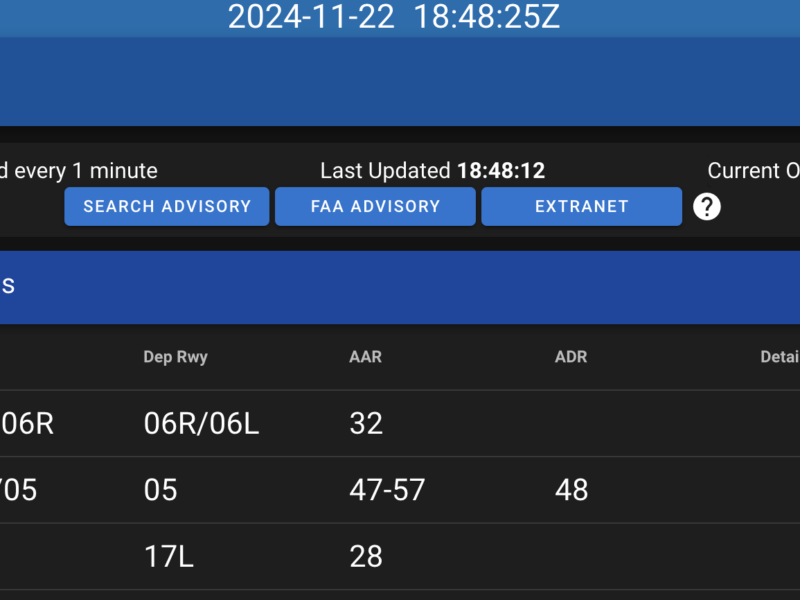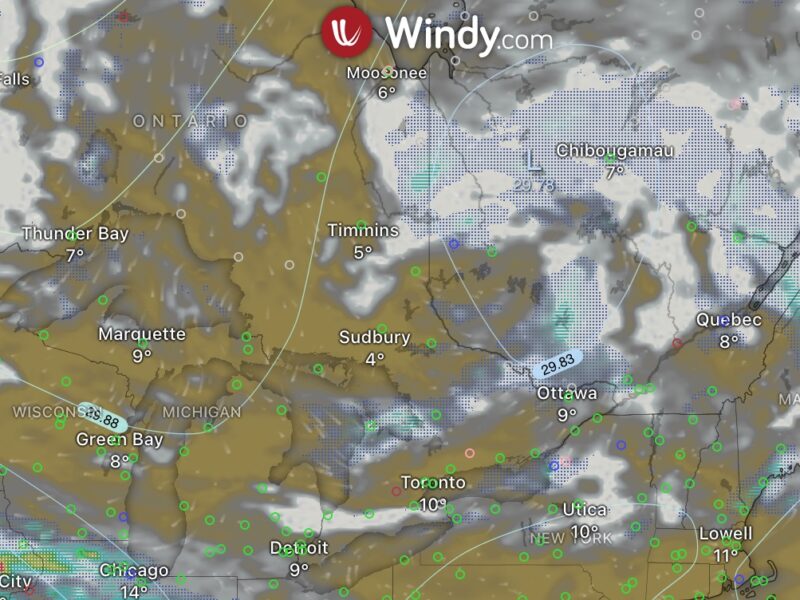My original plan was to fly to Kingston on Sunday. The weather didn’t play nice thanks to an approaching warm front. So, I decided to head west instead to London instead.
I took along a passenger, Sara, whom I’ve given a city tour before. This was the first time I’ve taken her on a X-Country flight. We hopped into a 172SP.
It was the first time the aircraft flew today, so I pre-warmed the engine using the portable heaters that are available at the school. I noticed (for the first time) that there was a placard stating that this aircraft was equipped with a Tanis heater and the plug was located on the underside of the cowling. Next time I’m at dispatch, I’m going to inquire about it and see if it is serviceable.
The airplane started on the first go! I wasn’t expecting that.
My flight plan was to take the “south route” around Pearsons Class “C” airspace. That involves flying along the shoreline until Oakville, then heading direct to London. This flight involved a few “firsts” for me:
– First time I’ve missed two calls from a controller, prompting him to ask how I read him.
– First time I’ve had to taxi at a controlled airport that was not my home airport.
– First time I had to change altitude for traffic, and missing such traffic by approx 300 feet.
– First time I’ve had to be vectored for downwind and base legs because I couldn’t find the airport during the day.
– First time I didn’t take off from the end of the runway, but partway down.
The flight to the airport seemd like to take forever. Looking at the GPS we were only grounding about 80 knots. 10 knots less than what I planned for. Enroute we were told by Toronto Terminal that there was a target, 2 miles orbiting at our altitude and he suggested that we descend 500 feet to 3000′ ASL. I complied and the traffic changed direction and passed over us in the descent. I was close enough to read the call-sign underneath his wing.
We were handed off to London tower about 15 miles back. There was another aircraft also inbound to London to my 9 o’clock. Tower cleared me to the left base for 15. I didn’t have the airport in sight, and let the tower know. He gave me vectors and it wasn’t until around 3 miles did I see the big weather radar dome (I think) that is located on the field.
I landed and exited on Taxiway Alpha. The taxiway is so wide that I was able to exit while other GA aircraft were waiting to take-off. I asked to get taxi instructions to the terminal building but was denied “due to security reasons”. I later found out that it was due to the fact that it was a secure area (being an international airport and such), for which you need a “Red Pass” to access. I was directed to an FBO where I could use the facilities.
This is when I realized that the Diamond Aircraft have their factory located here. As well as the “Katana Kafe“, which from looking at the menu, is hardly a cafe. Since we arrived at 3pm, the restaurant was closed (it reopened at 5pm for dinner). Dinner entrees were $28 and above. I thought cafe’s were supposed to be cheap? In the same building is the “Diamond swag shop”.
We hopped back in the plane and I watched what looked like a
We were given taxi instructions to runway 15 (which was 10 seconds away, on taxiway alpha) and to hold behind 3 other aircraft waiting to depart. But before I could continue, I had to give way to a 737 that was on Golf. You don’t hear that everyday (or ever) at Buttonville. The controller told us the remaining runway (which was 4800′, plenty for a 172) at Alpha and that we were cleared to take off. One thing I found interesting was that I was given a squawk code but as soon as we were cleared of the control zone was told to squawk 1200. I guess the code I was given was just to keep track of airplanes in the circuit/cz at London?
The rest of the flight back was uneventful.
This was a good lesson for me, and being the first flight since snowfall, a refresher on how different things look now that contrast has been reduced significantly with everything being white and grey. Although my taxi instructions to the FBO were simple (literally, “straight ahead”), I did come prepared with a full size map of the airport to help me.
Paying closer attention to the radio to not miss radio calls wont be a mistake I will make again. I’m glad that the controllers at London were patient with me. They were courteous and helpful the entire way.
Another 2.4 hours in the logbook!


Blake,
It was kind of weird to me when I read this entry about your flight to London. I took C-GOYJ to Kingston on Saturday morning. My passenger was a co-worker who won a United Way raffle that had me take him for a flight. He wanted to go to Kingston so, off we wnet.
I guess because I had booked the first flight of the day, 7:30 AM, the Dispatcher had made arrangements to put OYJ in the hanger along with some other airplanes. Unfortunately for us, we had to push 3 other airplanes out onto the ramp before we could get to OYJ but, it was well worth it.
I completed the walk-around in the warmth of the hanger, pushed the airplane out, started up and called for taxi instructions. The winds were calm and Ground control asked if I wanted 15 instead of 33 (the active). This was a first for me. I’venever been asked if I wanted to do something that made more sense, and it seemed as though it was out of the goodness of her heart. It made me feel good and my passenger was quite impressed.
We took off from 15 and climbed out at more than 1000 ft/min at Vx. Great climb rate due to the cold air and Penn Yan! We leveled off at 2000 and turned left to follow the 407 hwy. At about 5 miles east of Markham, we turned south to pick up the 401 and continued east. We were cleared through the Oshawa zone and continued east. I was absolutely amazed at a few things; the cloud layer over Lake Ontario gave this VFR pilot a fabulous view of the cloud tops; the air at 7500 feet is much, much, much colder than the air at 3500 feet; the Trenton Control Zone extends upwards to only 6000 feet and although you are not required to call them or tell them you are there, they were appreciative of the call and helped us out with traffic advisories; and finally, on a personal note, I made the best crosswind landing on 07, so sweet we barely felt the wheels touch the ground. This was the best landing I have ever made… to date.
We were able to make 120 to 125 kts ground speed on the way there with a slight cross/tailwind. On the way back we pushed 110.
We followed pretty much the same route on the way back, but proceeding west along the 401, I did not see the field until we were 3 miles out at 2500 feet and making 110 kts! The Tower called to ask if we were at the 3 mile point and I replied yes, thanks only to the DME. She cleared us for a right base for 33 and were number 2 for landing. My passenger picked out the Piper on short final before I did. Another first and a reminder of how difficult it is to pick out a white airplane against a white snow filled back ground.
… Al.
btw…
The “Huey” you saw was a Canadian CH 146 – Griffon. Here is an excerpt from the CAF website:
http://www.airforce.forces.gc.ca/site/equip/ch146/default_e.asp
“The Griffon is used at home and abroad for search and rescue (SAR) missions, surveillance and reconnaissance, casualty evacuation and counter-drug operations. The helicopter has also played a key role in many national and international humanitarian relief operations, including those for Manitoba’s Red River flood (Operation Assistance) in 1997; Eastern Canada’s ice storm (Operation Recuperation) in 1998; and the United Nations effort to stabilize Haiti (Operation Halo) in 2004.
The CH-146 is equipped with a hoist that enables it to extract people and cargo from almost any terrain. The Griffon can be equipped with a Forward-Looking Infrared (FLIR) system and a powerful searchlight, helping it to navigate and search in low-visibility conditions.
The aircraft can carry up to 13 people—two pilots, a flight engineer and 10 passengers—and has a maximum gross weight of nearly 5400 kg. Part of its heft comes from the armour that lines both the floor and the crew seats. Despite its weight, the Griffon can reach speeds up to 260 km/h.”
… Al.
Well thought I’d throw this out there. Took a night flight to CYSN tonight. First time I went west of Toronto. It was great. Terminal gave us any altitude, it wasn’t busy, and I had some college buddies for their first flights. First time I went west of T.O. and pretty much on a ‘real’ cross country at night.
Blake – are there any landing fees at CYXU? I want to go there as well as Wingham which is a nice little airport near Godrich. Night CX time! Woohoo. I also want to hit up Kingston some time as well.
How do you guys get ideas on where to go? I find it hard to decide where to go, as I want to pretty much go to a different airport every flight.
Hey Jonathan,
I was out tonight and noticed how it would be an awesome night for a flight. Glad it went well.
I’m unsure of the landing fees at CYXU. If you find out how much they are, let me know.
As for ideas of where to go. I always try to go someplace new every time. For that I use.. http://www.ourairports.com. I use it to pick a few places then narrow them down based on distance, weather, open/closed, etc..
Kingston is a cool airport too. Good at night as well, especially if the south runway is active as you take off over the water. Get some nice “black hole” illusion happening.